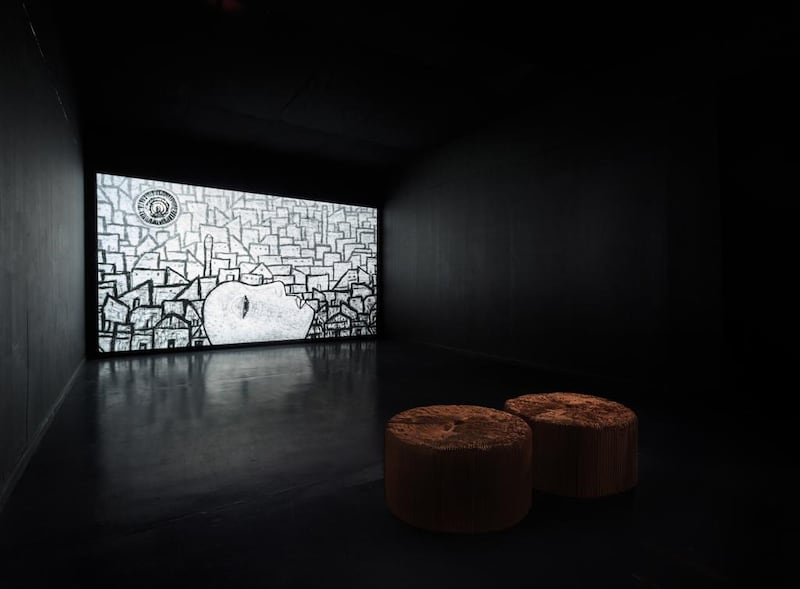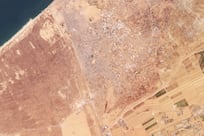In the centre of Ayyam Gallery’s largest space in Dubai’s Alserkal Avenue, Ali’s boat lies on the floor. The curved, wooden structure, reminiscent of a fishing boat and painted black, in keeping with the monotone elements of the exhibition, is repeated in the two large paintings on the wall. The image is taken from a letter that the artist Sadik Kwaish Alfraji received from Ali, his 9-year-old nephew in Iraq.
Ali drew a picture of a boat and told his uncle he wanted to escape and come and live with him in the Netherlands, where Alfraji has lived and worked for the last 20 years since himself fleeing from Baghdad during the war.
The emotionally charged exhibition features the original letter and a number of paintings, drawings and an animated video with a haunting soundtrack.
Driven By Storms (Ali's Boat) opened during Art Week in Dubai and has elicited an unprecedented response from visitors, many of whom admitted to shedding a tear or two as they viewed the exhibition.
“Sadik’s work is usually quite austere and sorrowful and there is always this issue about the burden of existence and the impossibility of escaping your destiny,” says Nat Muller, the show’s curator.
“What is happening in the exhibition is that on the one hand you get the desire and longing of a young boy in Iraq who very much wants to escape his situation, and on the other hand you have Sadik, who remembers his own childhood and has a longing to return to it. The artist and his nephew somehow merge.”
Alfraji’s skill is working with a childlike aesthetic on two-dimensional pieces such as the large paintings and the animation, which feature the figure of Ali, long limbed and clumsy either on the boat or next to it, and the repeated image of a head with reduced features as well as several other symbols.
The charm of his work comes from the fact that he is accessing a part of himself that is common to us all – in this case the desire to escape. “When Ali gave me the letter it affected me in an emotional way because of the symbol and the dream to flee. We all have a dream to flee from something. It doesn’t matter where you live or what you have, you always try to flee from some conditions of your existence. So the boat of Ali is my boat, your boat, any one of us has this boat. It is a crystal ball that takes us to another place. It is one of our human conditions to escape but we never get it because deeply we want to escape our existence. However, outside of that there is nothing.”
Despite this rather bleak outlook, which has been echoed in many of Alfraji's previous works, particularly the poignant The House that My Father Built (Once Upon a Time), a 2011 video about the death of his father, Muller says that this show has a more positive approach.
“There is a lighter touch here,” she says. “There is something dreamlike and playful to [the show] and even if it is very small, there is this possibility of hope as well, which is new for Sadik.”
The faces in the paintings and in the floor installation of 80 charcoal drawings presented in Perspex cases, are looking upwards and towards the stars. There is also a beating heart painted upon several of the figures, which is perhaps a lifeline, a ticket or a boat ride away from the sadness.
“There are interesting differences in scale, very large, almost monumental paintings that really arrest you as a viewer, a boat and then work on the floor that changes your gaze and direction. Here, all the people are facing up towards the sky, dreaming of sleeping or something else,” says Muller.
Alfraji himself has the last word: “The most beautiful and deep happiness is sorrow. If you go back to your memories you will see the ones you remember the most are those connected to sorrow. The truth behind all of us is sorrow; you cannot imagine God is laughing and dancing, the truth is absolutely sad.”
• Driven by Storms (Ali’s Boat) runs until April 30 at Ayyam Gallery, Alserkal Avenue, Al Quoz. A new monograph on Sadik Kwaish Alfraji is also available from the gallery
aseaman@thenational.ae





